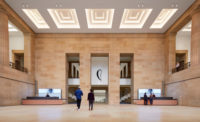A Long-Awaited Groundbreaking for Hadid's Broad Museum
Architects & Firms
Roughly a year behind its original schedule, the Zaha Hadid-designed Eli and Edythe Broad Art Museum will break ground on March 16 on the East Lansing campus of Michigan State University. When finished in 2012, it will be the second Hadid-designed building in the United States, after the Lois & Richard Rosenthal Center for Contemporary Art (2003) in Cincinnati, Ohio.
Click on the slide show icon to see additional photos.
The construction delay stemmed from the need to work out the practical implications of Hadid’s unusual louvered glass-and-metallic skin for the 46,000-square-foot Broad Museum, according to Linda Stanford, MSU’s associate provost. The university has been working with Hadid’s office, as well as a local firm, Troy-based Integrated Design Solutions, to conceive a structural plan and to decide on acceptable and cost-efficient materials.
Hadid’s scheme features an angular, low-slung horizontal building and outdoor sculpture garden.
In an e-mail exchange with RECORD, the London-based architect described the structure as a “sharp, directed body composed of sections of directional pleats that reflect the unique topography and circulation of the site.” The building will have “an ever-changing appearance while a person moves past it,” she adds, “creating curiosity while not fully revealing its content.”
The three-level museum, which includes a basement, will showcase modern art, some of which will come from the university’s existing collection and some, it is believed, will come from the Broads’ extensive collection of Modernist works. It will be the most avant-garde structure on Michigan State’s campus, which dates to the mid-19th century and includes a range of architectural styles, from late Victorian to International Style.
Hadid’s concept has raised eyebrows in the local architectural community and sparked a renewal of the long-running debate over the relationship between form and function in museum architecture. For her part, Hadid says “museum design should provide variety in terms of curatorial experience,” adding that “the concept of a ‘square box’ does not offer the curator any real opportunities to vary the interior conditions.” Hadid was the first female to win the Pritzker Architecture Prize, which she received in 2004.
Philanthropist and Michigan State University alumnus Eli Broad and his wife, Edythe, have committed $28 million to project, with $21 million designated for design and construction and $7 million to be used for acquisitions, exhibitions, and operations. Moreover, nearly $33 million in private funds has been raised for the project, which is expected to run between $40 million to $45 million.




